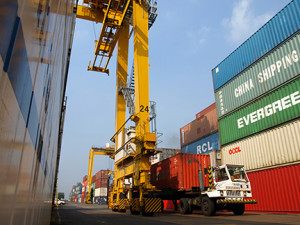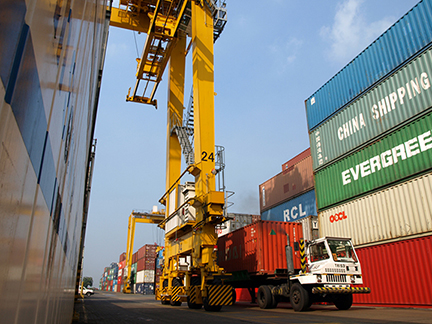
The operators of Manila’s two international terminals are putting in further measures to sustain manageable yard utilization levels and ensure the smooth flow of truck movements around the port.
Both Manila International Container Terminal (MICT) operator International Container Terminal Services, Inc. (ICTSI) and Manila South Harbor operator Asian Terminals Inc. (ATI) are beefing up their equipment arsenal this year. This, according to port officials during the port congestion updates forum organized by the Port Users Confederation on April 21 and the Senate hearing on port congestion on April 23.
ATI vice president Sean Perez said that by mid-2015, ATI will add five more rubber-tired gantries, six new side-loaders, and 18 additional internal transfer vehicles.
Moreover, back-up yards in four areas at Manila South Harbor’s expanded port zone are under ongoing development, according to Perez. The first portion, completed last January, increased Manila South Harbor’s capacity by 25%, while the rest will add another 14% yard capacity.
Perez also noted that ATI will continue allowing the use of the two additional gates at Manila South, which were opened last year to decompress the volume of trucks going in and coming out of its then two gates.
Christian Gonzalez, ICTSI head of Asia Pacific Region and the Subcontinent, said expansion of Berth 7 in MICT is continuing. ICTSI will be adding four RTGs, two reach stackers, and 42 terminal tractors. Equipment for its Laguna inland container terminal will likewise be added this year.
Moreover, Gonzalez said ICTSI is planning an additional stocking area and a new trucking area “which we are negotiating with the informal settlers”, a proposal “easier said than done but we’ll find a way.”
The port operator will also submit its proposal to build Berth 8 and eventually, Berth 9.
In addition, there are plans to barge containers to Cavite.
Launching new operating systems
Aside from new equipment and expanded yard space, both operators are introducing new systems.
ATI, according to Perez, is encouraging more customers to use its electronic-payment system introduced last year. Perez said currently, less than 10% of its customers apply e-payment, and these are mostly just the big companies.
Perez noted that ATI will continue its traffic light system that provides truckers with the real-time status of empty container slots per shipping line since “it’s been effective.” The system was implemented last year following discussions with truckers. ATI’s new gates will be equipped with the traffic lights, but the system can also be viewed on its website.
For MICT, Gonzalez said ICTSI will implement a new billing system starting May.
There are as well ongoing talks with the Bureau of Customs and Bureau of Internal Revenue “to streamline processes.” Gonzalez said they have had talks regarding customs export declaration, special permits to load, and adding more capacity to the PID division of BOC, all “to speed up the movement of trucks.”
Gonzalez said that while port operators were previously “very flexible” with shipping lines, they will now make any vessel arriving off-schedule to wait.
Both operators also called for support for the vehicle booking system, or container booking system, which Perez said will boost traffic flow and facilitate access to the terminal.
Aside from the booking system to be implemented in the fourth quarter, port operators implemented a pre-advise system for empty containers and export containers going to the ports. This means exporters or truckers must first wait for an advisory from the shipping lines if a vessel is arriving. This assures that when trucks go to the port, they have an appointment and will not have to queue.
“Empties and exports no longer have to wait for the booking to be made inside the office and they no longer have to wait for the checkers to check the container,” Gonzalez said.
He added that empty and export containers used to eat up space in the truck holding area while waiting for their turn. But now, all that’s left in the parking area are empty chassis, Gonzalez said.
Higher rates prove effective
Another measure that has helped reduce yard utilization significantly is the increase in storage rates, according to both operators.
To decongest the ports, the government in October last year increased storage rates of containers to discourage cargo owners from using the terminals as virtual warehouses.
Gonzalez said the dwell time of 10 big-time importers at MICT used to take 34 to 36 days before the truck ban. But with the higher rates, dwell time has gone down to three to seven days for these companies.
The average import dwell time of nine days in the first quarter of 2014 went down to seven days in the first quarter of 2015. Average dwell time for exports likewise declined to five days in 2015 from six in the first quarter of last year.
MICT and Manila South Harbor also reported that yard utilization has gone down to ideal levels. Yard utilization at MICT is now 57%, while Manila South Harbor’s laden and empty yards are utilized at 62% and 66%, respectively. Yard utilization at both terminals increased by about 100% during the peak of congestion.
Perez said Manila South Harbor’s truck movements have increased to 1,700 to 2,000 from 1,500 to 1,600 pre-truck ban.
To dispel claims that low utilization level is due to the low season, Gonzalez said that in February this year, which had only 28 days, MICT handled 6,000 twenty-foot equivalent units (TEUs) per day against the 1,650 to 1,700 during the peak season of October 2012. And despite the high volume, Gonzalez pointed out that utilization was at a low 57% in the first quarter of 2015.
“It doesn’t matter how high the volume is because number one, there is sufficient capacity in the port zone and number two, sufficient capacity can further be developed in the port if necessary,” Gonzalez said.
Earlier, both operators said they can sustain the downtrend even if the peak season begins.
Improving infrastructure a must
However, Gonzalez said even if the port has “unlimited capacity,” “it is only as good as the behavior of the customers and as good as the infrastructure that links the port to the customers.”
He said it is “imperative we get further support from the government to get direct connection from the major highways into the port area.”
Gonzalez said operators want to assist in “investing in the roads” but this will need political will to carry out. There is actually a project to connect the North and South Luzon Expressways, but port operators said there should be a road connecting this connector road directly to the terminals.
Moreover, Gonzalez said “we should not have any truck bans.” Port operators earlier said truck bans will defeat the purpose of the container booking system that is designed to spread traffic over a span of 24 hours.
Inland depots, such as ICTSI’s Laguna facility, should also be customs bonded, according to the port executive. This is “because even if you connect inland depot by rail, if they are not bonded, you have to wait for the clearance in the ports and it defeats the purpose.”
He also encouraged more efficiency on the water side by allowing more vessel-sharing agreements between carriers “to bring in the bigger ships” since Manila port is already prepared for large vessels.
Perez, for his part, said port operators “can only do so much” and that a strong partnership with stakeholders is important to sustain ideal levels.
He added that stakeholders should continue to pull out their containers during the free storage period, and to “maximize the use of weekend deliveries.” – Roumina Pablo





